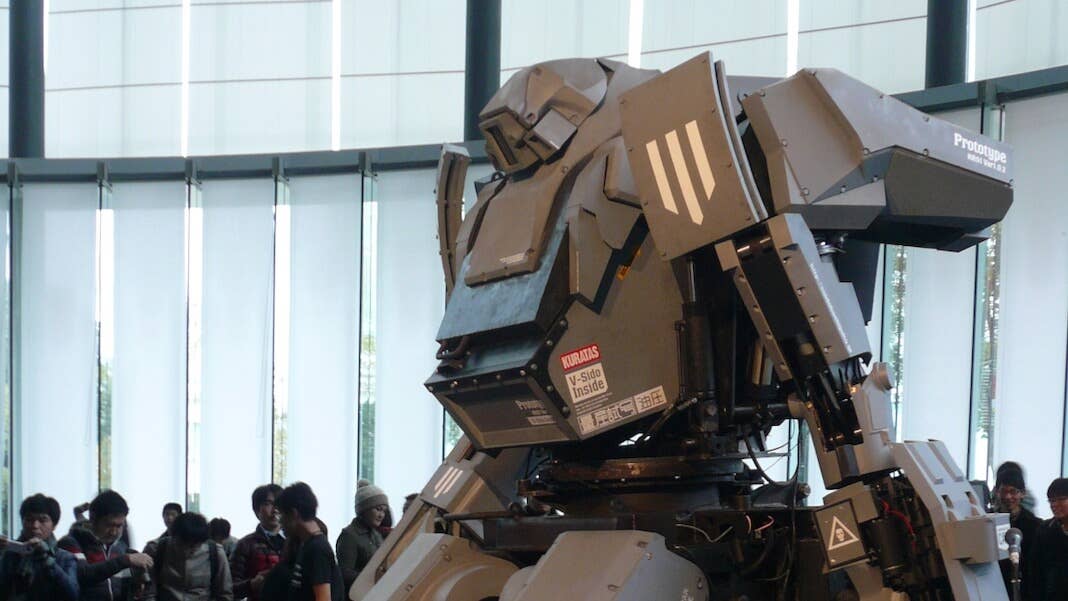That’s Right, Japan Has Created A Real Life 4 Ton Mech Robot

Share
Its name is Kuratas, and it's a dream come true for mech robot fans. That's right—it's your very own mecha to zoom around in and target your enemies...sort of. The Japanese firm Suidobashi Heavy Industry showed off its pilotable Gundam-style mecha at this year's Wonder Festival held outside Tokyo. Created out of a collaboration between artist Kogoro Kurata and roboticist Waturu Yoshizaki, the first footage of the mecha was posted on YouTube in April.
Kuratas is 13-feet tall, weighs 4 tons, is equipped with weaponry (relatively tame, relatively), and has a base cost of $1.3 million. It can be controlled by a pilot in the cockpit or by a smartphone. It also can be fully customized during the ordering process on the Suidobashi website, so you can get the bot in cool colors and tricked out just the way you want it. Unlike a mecha, though, it does not have jet boosters in the feet but instead rides on four wheels at a top speed of 10 kilometers per hour and 30 joints provide some movement.
Here is a video of its public unveiling:
As cool as Kuratas looks, it isn't a killing machine. The mecha has weapons, such as a LOHAS launcher that can shoot filled water bottles at a target, albeit inaccurately, and twin Gatling guns that track and fire off 6,000 BBs a minute that can be triggered by the pilot smiling, part of a tracking system that is aptly named the "Smile Shot."
Check out the instructional video, which shows off the features of the Kuratas:
Be Part of the Future
Sign up to receive top stories about groundbreaking technologies and visionary thinkers from SingularityHub.


According to Suidobashi, Kuratas is dubbed an "art project" to fulfill the dream of piloting your very own mecha. So, it's really a proof-of-concept kind of project, as it is currently difficult to imagine what you'd do with a mecha as a civilian. The idea here is to show off what can be done, fulfill some childhood dreams, and inspire others in the robotics field.
But Kuratas is far from a combat ready mecha.
One of the biggest problems to solve with robotic exoskeletons is mobility. Fans of anime know that mecha don't just fly, they're capable of a wide range of maneuvers with as much flexibility, speed, and responsiveness as a solider on the ground. Furthermore, mecha can transform from a humanoid form into other various modes that accentuate certain features, like flight. It also remains to be seen in what instances a mecha would be superior to modern firepower. Still, large-scale exoskeleton robots remain a R&D target in Japan, everything from the simple Land Walker mecha from 2006 to a power loader, and with each project, solutions to problems are found that can aid other robot projects.
From a futurist's point of view, the standoff between the Kuratas and the quadcopter in the video demonstration is intriguing. Are we peering into the future of combat when swarms of drones acting as surrogates of soldiers will go up against an enemy housed inside giant maneuverable mecha? Perhaps the battlefield will also be populated by soldiers in powered armor, like Robert Heinlein envisioned in the 1959 novel Starship Troopers. Or maybe all of these are wrong, and conflicts will be resolved by autonomous bots of destruction.
In the end, Kuratas brings science fiction into reality with one of the most iconic elements from cartoons from the last few decades. Let's hope it's the start of even more mecha awesomeness.
Image Credit: pha pha / Wikimedia Commons
David started writing for Singularity Hub in 2011 and served as editor-in-chief of the site from 2014 to 2017 and SU vice president of faculty, content, and curriculum from 2017 to 2019. His interests cover digital education, publishing, and media, but he'll always be a chemist at heart.
Related Articles

These Robots Are the Size of Single Cells and Cost Just a Penny Apiece

In Wild Experiment, Surgeon Uses Robot to Remove Blood Clot in Brain 4,000 Miles Away

A Squishy New Robotic ‘Eye’ Automatically Focuses Like Our Own
What we’re reading